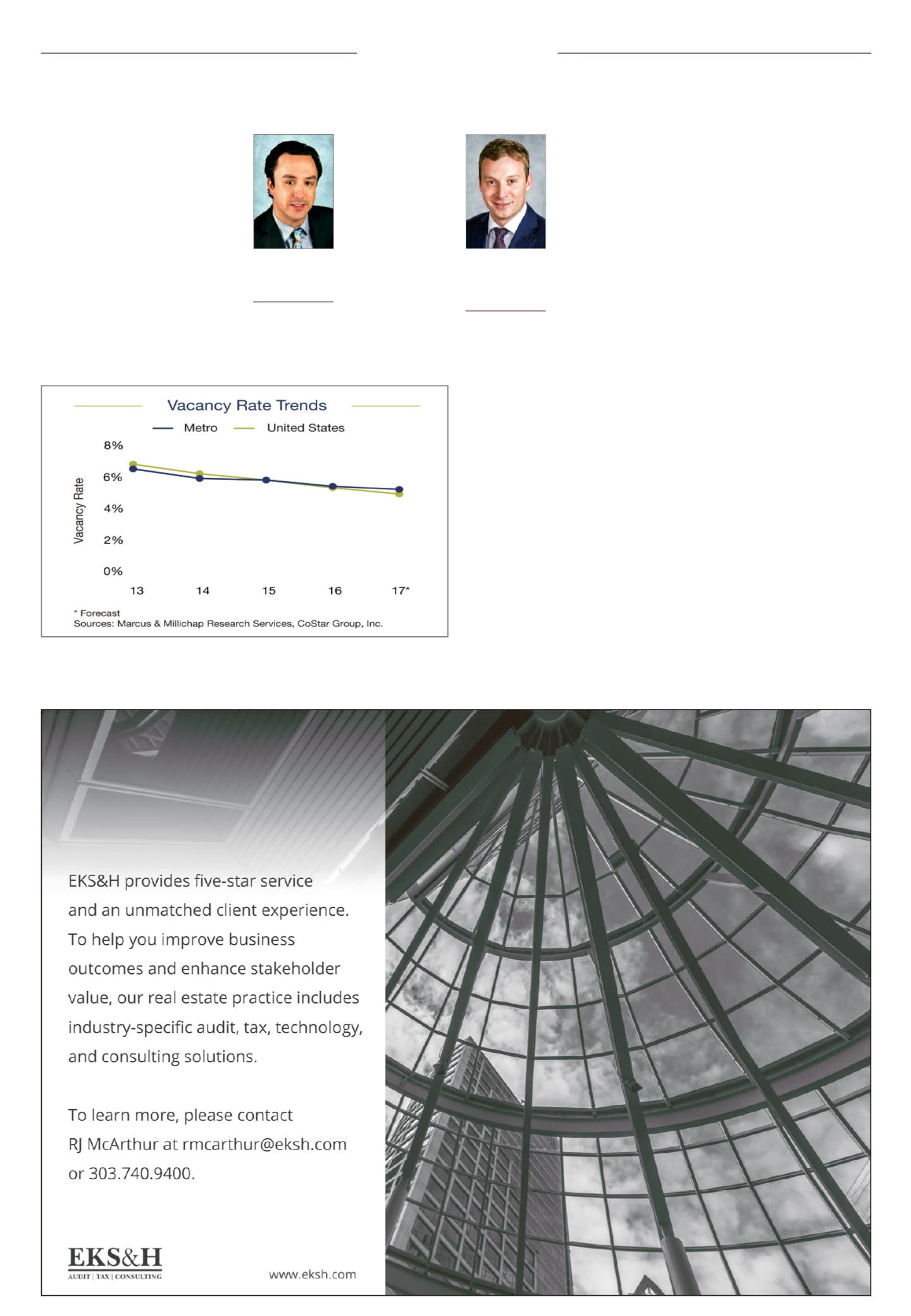

Page 4
— Retail Properties Quarterly — November 2017
www.crej.comMarket Update
D
enver’s roaring economy con-
tinues to attract businesses
and new residents, sustaining
demand for goods, services
and retail real estate. Ongo-
ing job growth well above the national
average has supported the unemploy-
ment rate contracting to 2.2 percent by
the end of the second quarter, one of
the lowest rates in the nation. By the
end of the year, the metro’s labor force
is expected to expand by 2.4 percent. In
addition, a rise in high-paying positions
has supported rising median house-
hold incomes, which is $17,100 more in
Denver than the national median and
translates to higher spending power.
These positive economic trends have
created robust demand for retail goods
and services at a
time when market-
wide concern over
the state of retail as
a product type has
been prevalent.
The largest retail
developments are
occurring in the out-
skirts of Denver in
suburban communi-
ties such as Castle
Rock andThornton.
Alberta Develop-
ment continues to deliver new retail
square footage as part of the planned
1-million-sf Promenade at Castle Rock.
A 139,000-sf Sam’s Club and a 125,000-
sf King Soopers opened earlier this
year, joining Ulta
Beauty and several
smaller-scale retail-
ers. On the northern
end of the Denver
metro area, Simon
broke ground on the
Denver Premium
Outlets, which will
contain 80 outlet
stores totaling more
than 330,000 sf.
While the larger
retail developments
mostly are occurring
in the outlying suburban communities,
in the urban core, older neighborhoods
are being redeveloped with mixed-use
apartment and office buildings that
also include retail components.The
most notable is the 9th and Colorado
Project, which is being developed by
Continuum and will include between
235,000 and 300,000 sf of retail space
once the project is fully completed.
In the first half of the year, 284,000 sf
of new space was delivered, with the
bulk of the activity occurring in the
northwest submarket. By the end of
2017, builders are slated to complete a
total of 750,000 sf of new retail space.
While this is an increase of 110,000 sf
from last year, it’s important to note
that the pace of development still is far
below the long-term average prior to
the recession. Developers’ restrained
and cautious approach to new retail
projects since the recession has kept
the market in balance and tenant and
investor demand for premium retail
product at very high levels.
Despite the increased deliveries this
year and a changing retail landscape,
strong retail demand will compress
vacancies in the Denver area.While
the third quarter saw a slight increase
in the vacancy rate due to new prod-
uct coming on line, the full-year 2017
absorption levels will once again out-
pace new inventory, resulting in the
vacancy rate dropping 20 basis points
and building on last year’s 40-basis-
point drop. And, as retail vacancies fall,
rents will continue to rise.
Overall, demand for retail space
is driving rent growth in Denver. As
of June 30, the average asking rent
increased to $17.47 per sf and is
expected to climb 4.8 percent to $17.60
per sf by the end of 2017, the larg-
est percentage increase in nine years
and surpassing the prerecession high.
While new retail construction routinely
commands $30 to $40 per sf for well-
located shop space premises.
Denver’s positive retail real estate
performance and the area’s favorable
long-term growth outlook continues to
attract investors. Single-tenant restau-
rants and fast-food stores remain the
prime choice of many buyers, driving
yields into the 5 percent range. Many
investors who have been priced out of
this market were able to achieve more
attractive yields – in the low 6 percent
range – in recently constructed mul-
titenant strip centers with long-term
leases and attractive tenant mixes. One
such asset we recently sold in Staple-
ton was leased to eight tenants, seven
of which had signed 10-year leases
with absolutely no landlord responsi-
bility to cover any property expenses.
These types of multitenant assets are
uniquely positioned to appeal to inves-
tors more familiar with single-tenant,
Denver’s retail market riding RockyMountain highsRyan Bowlby
Senior associate,
Marcus &
Millichap, Denver
Drew Isaac
First vice president
investments,
Marcus &
Millichap, Denver
Marcus & Millichap
While the third quarter saw a slight increase in the vacancy rate due to new product coming on
line, the full-year 2017 absorption levels will once again outpace new inventory, resulting in the
vacancy rate dropping 20 basis points and building on last year’s 40-basis-point drop.
Please see Bowlby, Page 26















